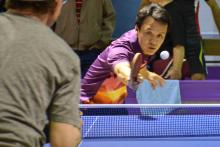Before and After
When developing a specific skill in table tennis, it is very important to think about the shot before and the shot after. Let me explain…
Scenario #1
Every time your opponent flips against you, you back away from the table and give a very weak loop. Instead of merely looking to improve your loop against the flip, you must think about the shot before and after. Let’s first examine your serve. How low is your serve? Can you control the depth? Can you generate very heavy backspin? By learning to serve better, you might weaken the flip which allows you to loop a softer flip. Let’s next examine the shot after the flip. Once you step back and loop the flip, you are a bit away from the table. Are you able to control a counterlooping rally away from the table? If you develop a counterloop from far, then backing up a bit isn’t a huge issue. As you can see, you must think about the shot before and the shot after.
Scenario #2
Every time your opponent serves short backspin to your forehand, he next pushes deep to your backhand and you continually give a weak opening. First, let’s think about your push. Does your push have enough variation? Are you able to change spin and depth while pushing to the angles or transition point? If you have a lower push, then your opponent is less likely to power push super fast. Next, let’s think about the follow-up ball. If you are just able to loop weak on the first ball and your opponent counterattacks, are you able to shorten your swing, stay close, and continue putting pressure on your opponent? As you can see, you must think about the shot before and the shot after.
Scenario #3
Every time you get into a forehand to forehand counterlooping rally away from the table, your opponent switches to your backhand and you miss your backhand counterloop. First, let’s think about the shot before the switch. If you could have switched first to his backhand, then you could have put him in the same predicament; or if you could have played sidespin wider to the forehand you could have made it more difficult for him, or if you could have stayed closer to the table, you could have covered your backhand better. Now, let’s think about the next shot. Instead of counterlooping with the backhand, what else could you have done? You could have moved and possibly used your forehand or you could have used backhand blocking or fishing? Remember, when stuck in a difficult situation, often playing ball control and defense for 3-4 shots is totally appropriate. Next, by fishing deep and low to your opponent, you might have the chance to again make a counterloop. As you can see, you must think about the shot before and the shot after.
I feel that many players are so focused on one aspect of the game that they can’t properly develop all aspect. A complete game is a game where the shots are LINKED together. This year, try to develop a great serve and receive game, while developing a solid opening, a consistent defense, the ability to rally long, and the ability to finish at the right time.
Before and After

Learn to fully develop your game
Category:



